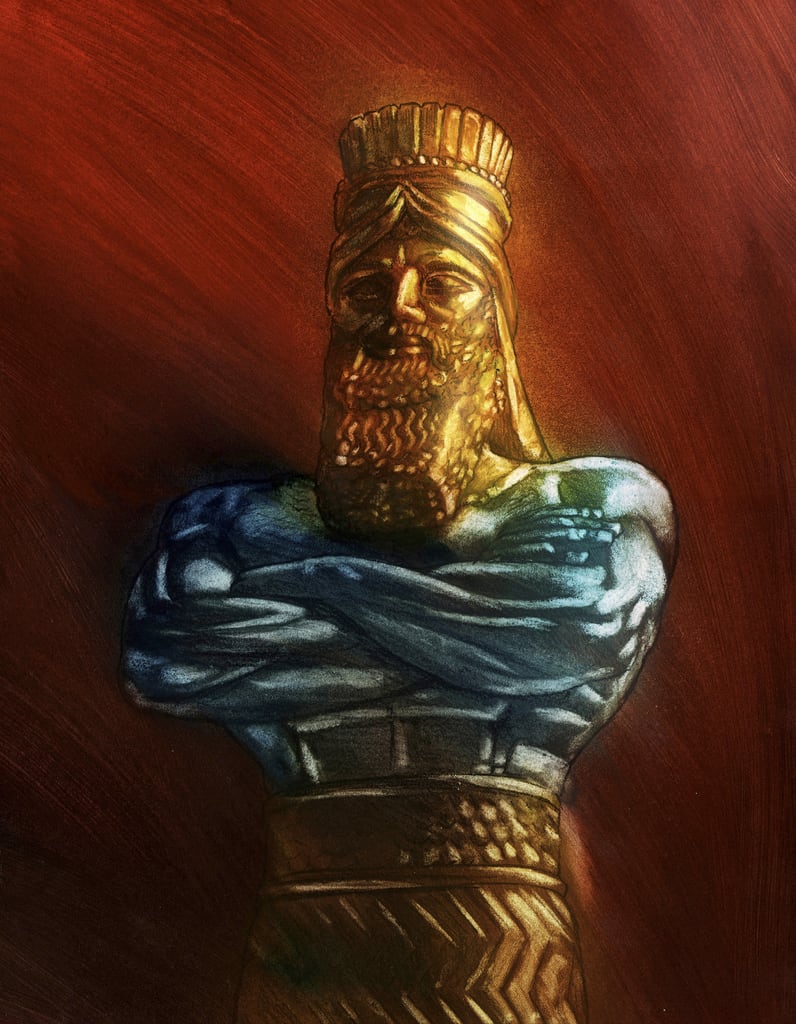
Unlock Deeper Meaning by Studying Biblical Symbolism and Allegory
Blood, swords, goats, oil… what does it all mean?
Especially if it is your first time reading through the Bible, coming across so many odd word choices can make you stop and think, “What did I just read?”
While the amount of symbolism and figurative language in both the Old Testament and the New Testaments can seem overwhelming at first, you’ll soon learn to recognize and understand their spiritual meanings—especially with the right guidance and tools for studying Scripture.
You may even find it quite fascinating!

Why so many symbols?
How do you explain something complex? Probably by using something simple as an example. Or if you wanted to tell the person in front of you a secret without the person beside you understanding, you use vague terms or codewords.
In both examples, you go beyond the literal definition of what you’re trying to say, so the intended people can understand the full meaning you want to express.
Symbols are everywhere.
We have visual symbols that represent law enforcement, highways, or hazardous waste. Some symbols are actions, like a bride and groom lighting a unity candle to represent joining their lives together.
Other symbols are words or expressions, such as calling a person your “rock” to illustrate how they are strong and steady. If a person constantly bothers you, however, you might call them a “thorn in your side.”
When it comes to the Bible, however, you might ask, “Why does it need to use so many weird symbols? Why use metaphors in a way that can seem literal? Why didn’t the authors just say what things actually were?”
To answer these questions, first think of why symbols would be used at all.
What do symbols actually do?
Symbols can add new levels of meaning to any message in many different ways
Symbols add color, feeling or emphasis.
For example, rather than just saying, “Satan is evil,” the devil is referred to as “roaring lion” who “prowls around,” looking for someone to “devour.” He’s also described as a dragon in Revelation.
These visuals create a more memorable, lasting effect. You might find yourself automatically applying traits of those creatures to the devil—insatiable hunger and violent disregard like a lion; powerful and destructive like a dragon.
Symbols convey significance.
Since purple dye was expensive and hard to come by, it was considered the color of royalty.
Another symbol of kingship—a crown—was used as mockery and torture when the soldiers shoved crown of thorns on Jesus’ head before He went to the cross.
Symbols of significance can be used in positive expression or negative expression.
Symbols describe something unfamiliar, special, or even dangerous.
If you saw something you’d never seen before and you didn’t know what it was, how would you describe it to a friend? You’d probably compare it to something similar-looking that was familiar to your friend. Otherwise, explaining it literally would be ineffective.
There may also be a time you would want to describe a new concept to a friend, but you didn’t want to give it away at the beginning. You knew they’d understand it better if they figured it out for themselves. This reasoning for symbolism is also common throughout fictional literature.
Symbolism adds depth to a message.
If you’ve taken a literature class in high school or college, you might remember several works that were full of symbolism. More often than not, the author used symbols to make the reader think deeper.
Or maybe you had to speak in code because you didn’t want people standing nearby to hear what you were telling your friend.
Even Jesus often used symbols because His own disciples did not yet understand the concepts He was teaching them ( Luke 8:9 and Matthew 15:5). He cautioned His disciples that if people weren’t in tune with Him, they would never be able to understand what biblical symbols meant (Matthew 13;10-15). He also commended them when He said,
“To you has been given the mystery of the kingdom of God; but those who are outside get everything in parables” (Mark 4:11, NAS).
“Outside”? That sounds divisive, but Jesus is separating those who are “inside” or “outside” the understanding of His word by whether or not they look to Him for understanding. That’s it.
In fact, the Apostle Paul, one of Jesus’ later followers, wrote:
“The person without the Spirit does not accept the things that come from the Spirit of God but considers them foolishness, and cannot understand them because they are discerned only through the Spirit” (1 Corinthians 2:14, NIV).
Some powerful truths are enhanced by religious symbolism and are meant for readers who look to God for insight. These truths, or their corresponding symbols, don’t have to be bizarre or extreme.
The thing is, without reading those passages as an intentional part of your journey to Jesus Christ, you’ll more than likely come away with a weak interpretation that only skims the surface of the deeper truth within. In other words, intent matters…as well as where you turn for further guidance.
Want to dig deeper into the meanings of different Bible symbols? Check out our free online Bible studies and sign up today.
Symbolism can protect an important message.
In other cases, sometimes Bible authors had to find a way to widely share information that would have been difficult, dangerous, or even impossible for people to understand while in their current political situations. When explaining events, or prophecies of the future, these authors had to hide the message in symbolism, so people who wanted to understand it could, but others—such as oppressive political authorities—could not.
One example of this is the book of Revelation.
The book’s author, John, was describing the astonishing visions of the future he received from God. The prophecies in this book connected his current time to the “end of time”: when Jesus Christ would return to Earth, stop the man-made madness, and take His believers with Him to heaven.
Revelation covers the power struggle of nations throughout history, and the effects of each of those paradigm shifts on the rest of the world. It shows how the forces of good and evil are constantly warring against each other all through the ages. Kings and kingdoms are represented by various animals that symbolized different traits, or by horns growing out of the heads of great beasts.
To further understand the purpose of these crazy, biblical symbols, imagine if a prolific author wrote something like that today…without using symbolism!
What if the book both named and described—in literal detail—who will rule which countries, who will conquer, and what will happen to the rest of the world as a result. Certain leaders would likely be offended, shocked, or overtaken by anger and disbelief that an author would publish a piece claiming to know all the gory details of future events.
Can you imagine the chaos?
News programs or talk shows might pick up the topic and make a spectacle of it. Some world powers might even try to “engineer” the progression of events, attempting to ensure the things written in the book didn’t come true (Daniel chapters 2 and 3).
In other words, all this uproar could affect the intended purpose of the book: to assure its readers that things of this world come and go—but even when things get bad, good will ultimately triumph over evil.

If the book is written with symbolic language, however, those looking for the true, biblical meaning within will get the picture. Meanwhile, any potentially concerned oppressors would either pay no mind or have no grounds to prove any slander or treason.
This was the case in John’s day, and symbolism served as a form of protection.

Where do the symbols in the Bible come from?
When each book of the Bible was being written, the Holy Spirit worked with each author to use the most appropriate symbol for the right time, place, and example.
God gifted each of the Bible’s writers with their own style, perspective, thoughts, and sometimes even visions or dreams. They wrote down their experiences in their own words.
Depending on their jobs, backgrounds, lifestyles, socio-economic status, etc., the biblical authors described what they learned in terms they were already familiar with. Most of the time they chose ordinary items to use for symbols—such as colors or animals—to help their readers make sense of complicated concepts.
For example, the Holy Spirit is symbolized by oil and likely olive oil, rather than unrefined oil from the ground. Olive oil was a staple in daily life during the Hebrew Bible times and it represented health and vitality. It was frequently used in anointing the sick as an act of dedicating them to the Lord.
In the New Testament, the Holy Spirit was symbolized by tongues of fire—which had other symbolic meanings as well, such as revival, purification, and warmth.
While reading, you’ll find hundreds of symbols in the Bible.
And some of those symbols will be clear right away, while others will require further study to determine exactly what they represent. When that happens, no need to be discouraged. Any powerful, life-changing book can be expected to require study and research to fully grasp its truths.
After all, this Book’s sole purpose is to explain an infinite God to finite beings.

Symbols in action (use of allegory in the Bible)
As we go deeper into parts of the Bible known for their use of symbolism, you’ll find passages with a collection of “storified” symbols that work together to illustrate a principle. This is a literary device called allegory. Its defining characteristic is that ideas are represented as people, or sometimes as personified animals.
One of the most common uses of allegory is within a fable you might have heard when you were young: “The Tortoise and the Hare.”
The fast Hare constantly picks on the slow Tortoise, until the Tortoise finally challenges him to a race. Confident that he will win, the Hare takes a nap during the race. During the Hare’s nap, the Tortoise passes him and wins the race.
The two key symbols in this fable are the tortoise, representing slowness, and the hare, representing speed and haste. The story of these two animals also represents something as a whole—the idea that innate ability isn’t everything (especially when accompanied by arrogance), and dedication and follow-through can accomplish the same goals.
“Slow and steady wins the race.”
You can also find helpful uses of allegory all throughout the Bible.
One example can be found in 2 Samuel 12, when God had a prophet, Nathan, approach King David with a message.
At the time, the king had recently schemed to have a man killed so he could take the man’s wife for himself. God was quite displeased with David’s actions and sent Nathan to rebuke the king.
The prophet didn’t directly accuse King David of murder, covetousness, and adultery. Instead, he told a story of a rich man with many sheep, and a poor man with only one. When the rich man wanted to entertain guests and prepare dinner, instead of killing one of his own sheep, he took the one special sheep from the poor man.
Not considering the underlying meaning, King David was furious that someone could do such a thing. And that’s when Nathan said:
“You are that man!”
The rich man represented the king. The poor man represented the husband and his one beloved sheep represented the wife King David stole from him.
The message sunk in. With this new perspective the allegory provided, King David realized the depth of his own guilt and sinfulness before God and was remorseful.
In the Gospels of the New Testament, you’ll find several uses of allegory within parables Jesus told to teach His followers about life, relationships, and what it means to follow God.
Jesus spent His time healing people, but the rest of His time He spent blowing people’s minds with his teaching—specifically his crazy stories:
“‘The kingdom of heaven is like treasure hidden in a field, which a man found and covered up. Then in his joy he goes and sells all that he has and buys that field. Again, the kingdom of heaven is like a merchant in search of fine pearls, who, on finding one pearl of great value, went and sold all that he had and bought it” (Matthew 13: 44-46, ESV).
The two super-short stories about hidden treasure and pearls are taken from Matthew 13. Interestingly enough, this entire chapter of the Bible is about Jesus—the Master Storyteller and Communicator—telling His followers deep, life-changing, spiritual truth—in symbols!
No doubt there were many who were confused and didn’t understand what He meant by these two short stories. So, let’s look at what they really mean.
Jesus spent a large amount of time trying His best to make people understand what His Kingdom would be like and how it would be different from any other Kingdom. In this first parable He explains His Kingdom as a priceless treasure, and in the next story, He demonstrates how the Kingdom is a “pearl of great value,” worth more than any other possession someone could have.
The point of both stories is to explain to people who are searching for God’s Kingdom what the kingdom is like. These quick stories especially emphasize the desirable beauty of the kingdom and how it is something like we’ve never seen before. Just having these short descriptions stir up feelings of excitement in the hearts of God’s people.

Overcoming “Symbolophobia”
Yes, it’s an actual word.
It literally means a fear of symbols.
But you don’t have to be symbolophobic!
With these four, easy steps you can begin the process of overcoming your fear. Okay… maybe “fear” isn’t the right word, but at least uncertainty or hesitation that comes from reading sacred Scripture with startling symbols.
1. Pray First:
Always start any kind of Bible study with a prayer. In the Bible, God promises that, if you ask Him to give you wisdom in understanding and applying the biblical lesson, He will.
2. Yes, You Can Use Your Common Sense:
Most—not all—of the symbols you find in the Bible are not based in literal reality, so they probably aren’t meant to be taken at face value. For instance, when was the last time you saw a dragon or a 10-horned beast? It’s safe to assume they must symbolize something else.
3. Read in Context:
The Bible is its own best interpreter. If you’re not sure about a symbol or allegory, don’t rush to judgment or give up. Keep reading. Look for other spots in the Bible that use the same figurative language or mention the same situations. You’ll often find more.
And nowadays most Bibles have concordances or other interpretative study tools that can be used to help you understand what the symbols mean. You can find a ton of them online. One great one is https://www.amazingfacts.org.
4. Ask For Assistance:
When run into a difficult spot in the Bible, finding a family member, friend, or neighbor—or even contacting the pastor at your local Adventist Church—can help you get the guidance and encouragement you need. The Bible encourages us to “meet together” to study God’s Word.
The Lord has given you the opportunity to discover deep spiritual truths that can, not only provide better understanding, but can influence your worldview in helpful ways.
When you diligently study the Bible’s symbols, metaphors, parables, and allegories, you can learn amazing things about the true character of God and His will for your life.
Start your Bible study today!
Want to see how an understanding of Bible symbolism can make your study of the Bible more exciting? Begin this free online Bible study today and begin on your discovery!
